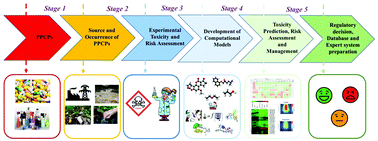Ecotoxicological assessment of pharmaceuticals and personal care products using predictive toxicology approaches†
Abstract
The use of active pharmaceutical ingredients (APIs) and personal care products (PCPs) is growing day by day all over the world. Thus, these materials have appeared as contaminants of emerging concern (CEC) responsible for hazards and toxicity towards aquatic and terrestrial living systems as well as to humans. Regulatory agencies from all over the world have formulated multiple rules, guidelines and regulations for the risk assessment of pharmaceuticals and PCPs (PPCPs) to the ecosystem. As the generation of a huge amount of experimental data is time consuming and costly, and also requires sacrifice of a large number of animals, computational modeling or in silico approaches are proving to be an efficient technique for not only risk assessment, but also for risk management and data gap filling. The present review deals with the critical assessment of the hazardous potential of PPCPs in the environment. The importance of in silico modeling approaches for the environmental toxicity endpoints to diverse organisms covering all compartments of taxonomy, details of the most commonly employed endpoints, ecotoxicity databases and expert systems as rapid screening tools are discussed meticulously with complete mechanistic interpretations of in silico models reported over the years.



 Please wait while we load your content...
Please wait while we load your content...
